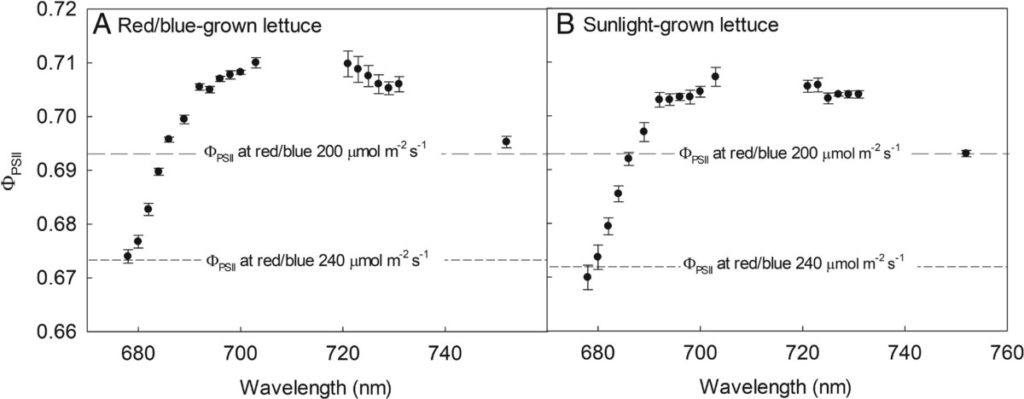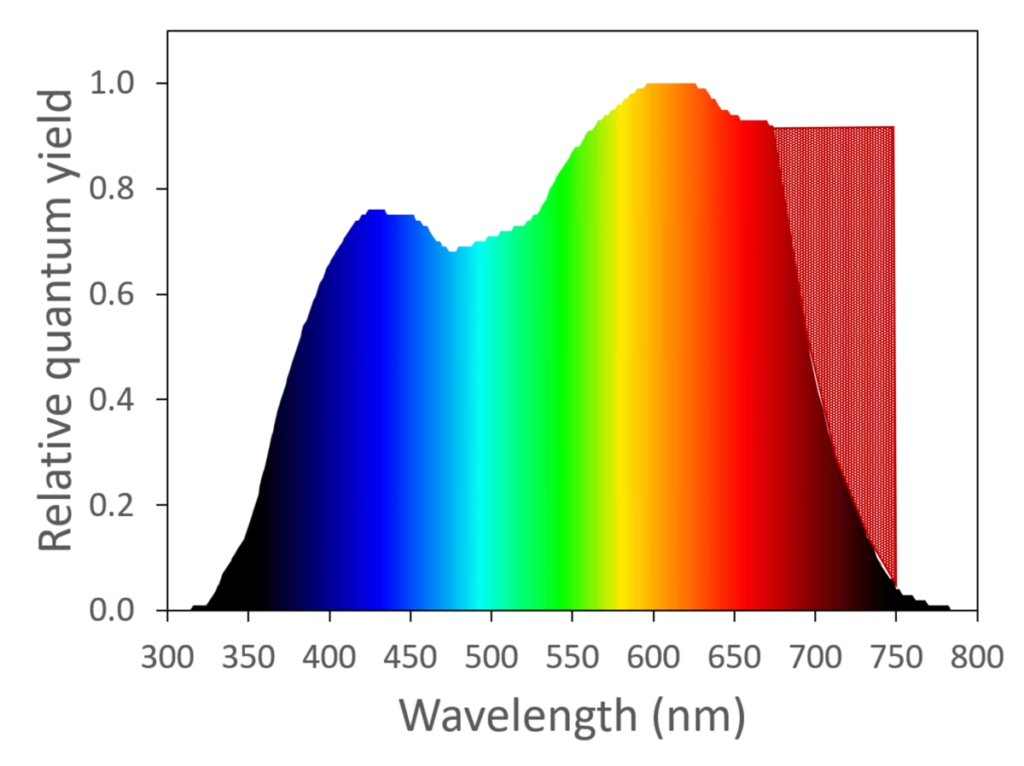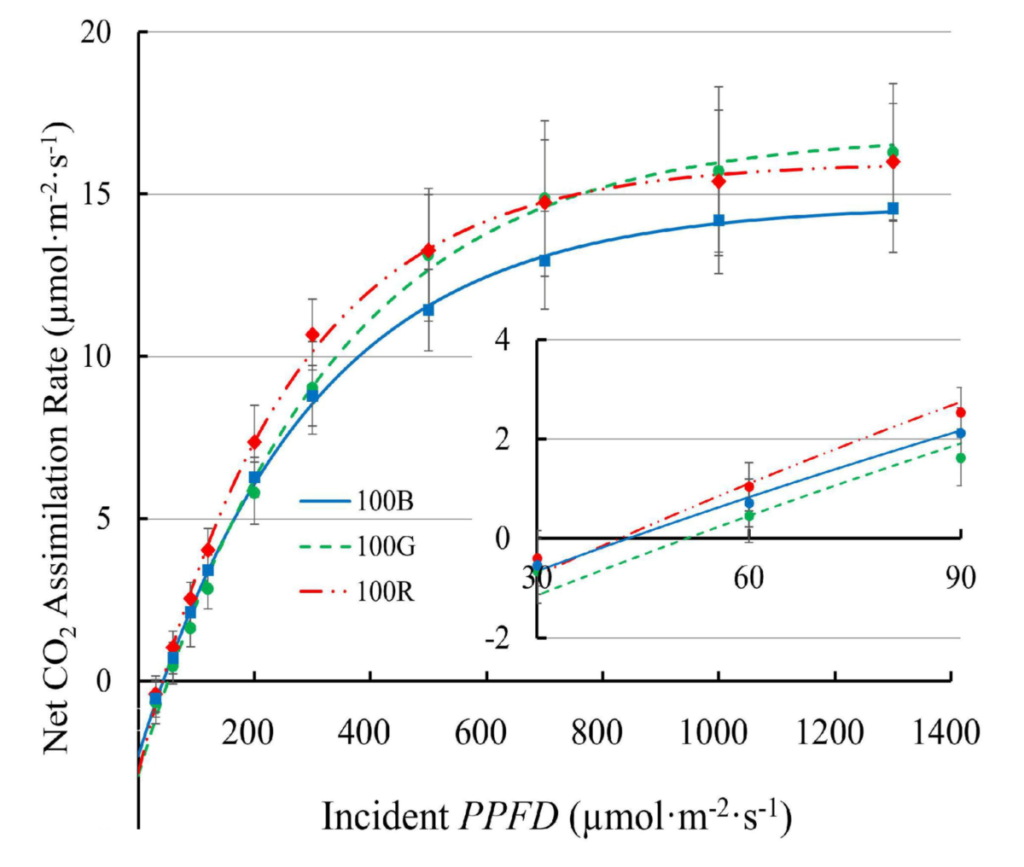Understanding spectral effects on leaf and canopy photosynthesis is crucial for ecology, plant biology, agronomy, horticulture, and especially controlled environment agriculture (CEA). In CEA (greenhouses and vertical farms), much of the light required for crop growth has to be provided using grow lights, either as sole-source lighting in vertical farms, or as supplemental lighting in greenhouses.
Spectral effects on photosynthesis have been studied for almost a century (check out this 1937 paper by Hoover!), but such studies have consistently used narrow waveband lights and low light intensities. Although this has resulted in great scientific insights, such as the discovery on photosystem I and II, it also has resulted in persistent misconceptions related to spectral effects on photosynthesis. Two of those misconceptions are that:
- Far-red light is not used for photosynthesis. Wrong!
- Green light is not used (efficiently) for photosynthesis. Also wrong!
Far-red light and photosynthesis

Robert Emerson published the synergistic effect of red and fa-red light back in 1957. His work led to the discovery of photosynthesis I and II, but the implications of this synergism were long overlooked. Subsequent studies on spectral effects on photosynthesis ignored this synergism. And because far-red light has little or no photosynthetic activity by itself, this has lef to the widespread belief that far-red light is not photosynhtetically active.
Image from: J. Myers. Enhancement studies in photosynthesis. Annu. Rev. Plant Physiol., 22 (1971), pp. 289-312, based on Emerson’s work.

In 2017, we started revisiting the photosynthetic activity of far-red light. We found that adding far-red to either red/blue or white LED light (both very low in far-red) increased the quantum yield of photosystem II (a measure of the efficiency with which absorbed photons are used to drive photosynthetic electron transport).
In addition, adding far-red light reduced non-photochemical quenching (the conversion of the energy from absorbed photons into heat). So far-red my be more beneficial than previously thought!
From Zhen and van Iersel, 2017, https://doi.org/10.1016/j.jplph.2016.12.004

Since far-red light increases how efficiently absorbed photons are sued for photosynthesis, it is not surprising that far-red light increased photosynthesis. Far-red photons also increase net CO2 assimilation per photon in the 400 – 700 nm. The latter is especially evident at lower PPFDs.
From Zhen and van Iersel, 2017, https://doi.org/10.1016/j.jplph.2016.12.004

In subsequent work, we assessed which wavelengths of far-red light are photosynthetically active. We added light from very narrow waveband lasers to red/blue or white LED light. As the wavelength of the far-red light increases from 680to ~700 nm, the quantum yield of photosystem II gradually increases. This suggests that longer wavelength photons excite photosystem I more efficiently than photosystem II. Photons up to at least 732 nm are photosynthetically active. Because of the lack of lasers with wavelengths from 733 to 751 nm, we couldn’t test those wavelengths. Photons with a wavelength of 752 nm did not have photosynthetic activity.
From Zhen et al, 2018. https://doi.org/10.1111/ppl.12834

Subsequent work by Shuyang Zhen and Bruce Bugbee showed that our results at the leaf level also hold true at the canopy level. We thus argued that the definition of photosynthetically active radiation should be extended to include 700 – 750 nm photons: ePAR, or extended Photosynthetically Active Radiation. To see our detailed argument for this change, please see:
Why Far-Red Photons Should Be Included in the Definition of Photosynthetic Photons and the Measurement of Horticultural Fixture Efficacy
Shuyang Zhen, Marc van Iersel and Bruce Bugbee
Front. Plant Sci., 2021 https://doi.org/10.3389/fpls.2021.693445
Or watch our webinar.
Green light and photosynthesis

Most leaves are green because they reflect more, and absorb less, green light than other colors of light. The reason for the lower absorptance in the green part of the spectrum is because chlorophyll absorbs red and blue light better than green light. As a matter of fact, absorptance by chlorophyll in the green part of the light spectrum is very low, in when chlorophyll is extracted from leaves and dissolved in an organic solvent. However, intact leaves absorb green light quite well (figure on the left), and entire canopies absorb green light even better. And photosynthetic research has long shown that green light us used pretty efficiently (see for example Keith McCree’s 1971 paper).
Image: Liu and van Iersel. 2021. Front. Plant Sci. https://doi.org/10.3389/fpls.2021.619987
So where does the myth that green light is not used (efficiently) for photosynthesis come from. At least partly to blame are grow light manufacturers. In the early days of LED grow lights almost all grow lights used red and blue LEDs. And marketing departments took advantage of the high absorptance of red and blue light by chlorophyll: they explained that red and blue LEDs were best because that light was absorbed best by chlorophyll and plants. Nice explanation, but not truthful. The real reason that early LED grow lights used red and blue LEDs: those were simply the only affordable LEDs available. There really was no other option.
However, the relatively low absorptance of green light provides an advantage: green light can penetrate deeper into leaves and canopies. The deeper penetration into leaves allows green light to drive photosynthesis in cells that receive very little red and blue light (which is largely absorbed in the uppermost cell layers). Work by Thomas Vogelmann‘s and Ichiro Terashima‘s research groups has shown that this is indeed the case.

We have quantified the photosynthetic efficacy of red, green, and blue light at a wide range of photosynthetic photon flux densities. At low PPFDs, red light is used slightly more efficiently than blue or green light. At high PPFD, however, green light is used with similar efficiency as red light, and more efficiently than blue light.
We also looked for interactive effects of red, green, and blue light and found none.
Not surprisingly, we found that the effects of different light spectra and intensities on photosynthesis was explained by the effect on photosynthetic electron transport (the light reactions), not Rubisco activity.
For more details on our work on this topic see:
Photosynthetic Physiology of Blue, Green, and Red Light: Light Intensity Effects and Underlying Mechanisms
Jun Liu and Marc W. van Iersel, 2021. Front. Plant Sci. https://doi.org/10.3389/fpls.2021.619987
